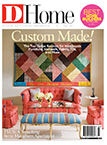 |
| The Sands love to cook, so Storm, Leigh, and 18-month-old Hunt spend a lot of time in the kitchen. |
When I was about 7 years old, I asked my parents for a brother for my birthday. I already had two, but I associated large families with excitement, almost assuredly because of my aunt and uncle’s family of four boys. The Sands’ household fascinated me: My aunt and uncle were sophisticated and attractive, like a glamorous Old Hollywood couple, living in their exquisitely decorated home, my dark-haired cousins running and laughing through it, knocking each other over but somehow missing valuable antiques. The Sands were exotic. Their Christmas cards reflected trips to places I had only seen in schoolbooks—Thailand, Alaska, Egypt, Kenya.
When my cousin Storm, the third in the Sands line, married Leigh McKay, the third in line of four girls, it just made sense. They were Dallas people. Both grew up in Highland Park, ran cross-country, went to the same Presbyterian church, had mutual family friends, loved the outdoors, and were part of a big family. They met for the first time after college—coordinated by Storm’s sister-in-law and Leigh’s sister—but one date was all it took. They were a natural pair.
 |
| Home for the Sands is a 3,600-square-foot, 1929 Tudor, five blocks from Leigh’s parents, several blocks from Storm’s parents and grandparents, and a short bicycle ride to pick up groceries at Highland Park Village. |
Once, in response to me wanting to move away from Dallas, Storm asked, “Well, where would you go? Why would you want to live anywhere else?” To me, this illustrates something about their thought process. They may venture out, but they love where they live.
Right after their wedding, they moved to Jackson Hole, Wyo., in search of low-stress employment and the mountain life of hiking and skiing for a year and a half, a period the family jokingly referred to as “their honeymoon.” Two years ago when Leigh became pregnant with son Hunt, they felt it was time to go home. “We wanted to get back to reality and put our roots down,” Leigh says.
Home for my cousins turns out to be a 3,600-square-foot, 1929 Tudor. It’s five blocks from Leigh’s parents, several blocks from Storm’s parents and grandparents, and a short bicycle ride to pick up groceries in Highland Park Village. The house had good bones and a charming face but needed a little makeup and an expansion. “We wanted something we could make into our own, something we could grow into,” Storm says.
 |
 |
| LEFT: Vegetable painting by Austin artist Ellen Berlman, Swedish hand-carved chair, and milk glass tabletop with iron base. RIGHT: An uncluttered hallway is romanticized by a screen, acquired from a San Antonio building, which has iron brackets to raise it from the wall, give it depth, and create shadows. “I love to work with iron, to find pieces people can use in new ways in their homes,” designer Betty Sewell says. Rug from Art of Old India, Italian iron lantern, and French chaise from The Mews. |
|
The renovation took about six months. Leigh’s mother was enlisted as contractor and to assist with the architect. Longtime family friend Betty Sewell decorated the interiors. They gutted the kitchen and added to the back of the house, creating lofty 10-foot ceilings and a large, welcoming kitchen/family room, which is Storm’s favorite. He likes the feel of the room—its good lighting, tall ceilings, and comfortable furniture.

|
| Sewell uses iron for wall art, coffee tables, and headboards, such as an early 1800s French wall sconce from Uncommon Objects in Austin above the mantel. Chairs purchased from a New York estate sale are covered in zebra cowhide; colorful Turkish blankets drape a sofa from Quatrine. Candlesticks and Swedish hand-carved chairs in original green paint are from Betty Sewell Design. |
My cousins spend a lot of evenings in that room, with Hunt tottering around as Storm and Leigh make one of their favorite dishes—chili, gumbo, pasta, or anything smoked or grilled.
“Name it, I cook it,” Storm says, laughing, as he boasts of skills he acquired as an intern in the celebrated kitchen at the Mansion on Turtle Creek. “I make one heck of a Caesar salad. We eat too much on the weekends, so we’ll have it for a meal on Sunday.”
The kitchen/family room also serves to entertain any of the 127 family members in town—though not all at once.
 |
 |
| LEFT: Six Restoration Hardware chairs and 1900s Italian wooden end chairs from Betty Sewell Design surround the dining room table, topped with a woven grass cloth table runner from Antigua and iron base and copper bowl. Mirror from Art of Old India; carved chest from India; collected wooden, metal, and mercury glass candlesticks; ceramic pot filled with mother-in-law’s tongue. RIGHT: A streamlined color scheme dictated by Benjamin Moore’s “White Sands” paint sets the tone for a clean, comfortable master bedroom. An overturned glass vase forms a lamp base on pine dresser. Kilim rug, 1890 pine chair with French fabric, silk pillowcases. | |
“We have an open-door policy,” Leigh says. “People are always dropping by.” I’m one of them, since my office at the magazine is nearby. With a flurry of guests and an 18-month-old, they are often asked, “how do you have a nice house and a kid?”
Their solution was to make the second floor—where the master and guest bedrooms, three bathrooms, and nursery are—more kid-friendly. By limiting the clutter that often defines homes with young children, Leigh and Storm get to have a grown-up house. A little bit of segregation also helps make the child-centered areas all the more whimsical and unexpected. A friendly lion and brown-crayoned giraffe, drawn by Hunt’s cousin Emma Parker, adorn the nursery. Sewell liked Emma’s art so much that she commissioned more, including a penguin, dog, elephant, and kitty.

|
| Sewell, whose design eye developed under her mentor Ken Blasingame, designer to Laura Bush, achieves continuity among disparate elements in the home through attention to scale, which she considers most important in design. When everything is at the correct scale, it creates drama, she says, and once that’s set, the “special accessories” can accent. In the office, desk from Art of Old India, carved French chair, art from Dallas artist Joan Winter, Mexican aluminum candelabras from Betty Sewell Design, ducks from White Elephant Antiques, chickens from Jackson Hole antiques show, and Turkish pots. |
The house just looks like Storm and Leigh. It’s warm, friendly, and sophisticated. They’re well-traveled, and the house reflects that in Storm’s black and white photography taken in Utah and New Mexico, and their collection of old ceramic pottery. Despite the antiques and 18th century ironwork, the rooms seem to glow with energy and youth.
 |
 |
| LEFT: Sewell had the window replaced with milk glass and had open, 3.5-inch shelving installed to open up the kitchen. She also collected the hand-painted, carved wood 1920s Mexican plates for the couple. “Betty likes the same things that I do, which made it easy,” Leigh says. The aluminum bar stools, Viking stainless steel appliances, stainless steel workstation, and straight-lined drawer pulls create a clean look. RIGHT: 18-month-old Hunt plays in his nursery. Animal artwork by Hunt’s cousin Emma Parker. Crib from Stephanie Anne. | |
“The house was very dark when they bought it,” Sewell says. “We opened it up and made it seem more spacious by changing the configuration of some walls, adding large shelving and tall panels above the windows, removing interior doors, and giving the house nice flow from room to room.

|
| This kitchen/family room, which was added to the back of the house, is Storm’s favorite. In foreground are a ceramic pot from Jackson Hole, checked throw from Forty Five Ten, silver tray from a Dallas estate sale, 1800s Oriental vases, and candlesticks and pots from Betty Sewell Design on a pine worktable. |
“Fresh white walls and simple window coverings keep things airy and open. The idea is to maximize light and enhance the beauty of the furniture, accessories, and art.”
Leigh and Betty collected most of the furniture and accessories at antique shows and their favorite Dallas spots, The Mews, Betty Sewell Design, and Art of Old India, but the few hand-me-downs are hardly closet worthy. The Kilim rugs from Leigh’s parents, a dining room table from Storm’s parents, and a chandelier from Storm’s grandmother stand in as icons of family tradition.
Now completed, the house reminds me of where Storm grew up—a home that bridges sophistication and youth, quiet nights and lively family gatherings.





